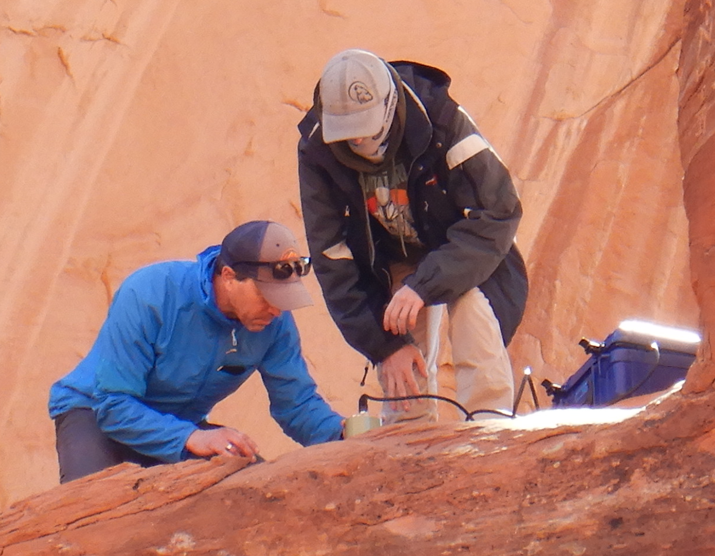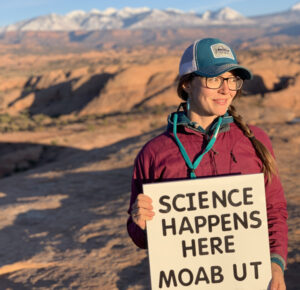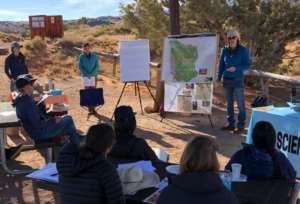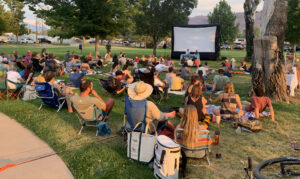
Our “Local STEM” series highlights local government and community initiatives and organizations in areas that relate to STEM.
By Robin Mays
Science Moab is an organization based in Moab, Utah, with a mission to make place-based science accessible to all. Through efforts such as public engagement, student internships, and science communication training for recreation guides, Science Moab connects knowledge holders with community members and visitors to public lands who are hungry for a deeper understanding of the landscape around them. ESAL spoke with Kristina Young, founder and executive director, to learn more about their programs and philosophy.
RM: Can you tell me a little bit about how Science Moab got started?
Young: I moved to Moab in 2011 and became involved in cool research happening in the area, but I saw a need to connect local science with the community. I went to our local radio station, KZMU, and asked if I could interview scientists on air, which I thought would be the best way to get their words out. Our community radio station is amazing and immediately agreed. Science Moab grew from there. We wanted to be a conduit for sharing information with the community because it's so relevant to everyone's lives, it's just not always accessible. We're fortunate to have such a passionate team of scientists and volunteers giving their time and efforts to our work.

Kristina Young
RM: Science Moab includes a range of programs: a podcast, live events, school programs, and the Science Certified program. What has been your approach in pursuing new opportunities?
Young: What motivates us is presenting place-based science and matching that to what the community is interested in. All of our initiatives come from suggestions from community members. I wish I could take credit for the ideas but I can't; people in the community saw a need and made it happen. After we started the podcast, someone suggested that we have in-person events for scientists to give talks in community hang-outs, such as our local tavern. That's how our live events started.
The School to Science program got started when one of the local scientists here mentioned his experience being connected with a scientist in a community program when he was a student. There are so many people in our area doing incredible science that it was no-brainer to start a similar program.
We created the Science Certified program because the community recognized that the three and a half million visitors coming through Moab every year don't necessarily have experience recreating in a desert. We need to make sure visitors know how to engage with the landscape appropriately. We work with local guides to develop their science communication skills so that they effectively communicate how deserts work and create buy-in from our visitors.
RM: Could you explain more about the place-based science engagement approach?
Young: I think the reason our programming has been successful is because we are not talking about an abstract concept, we’re talking about people’s backyard. We can point to landscapes and tell people that research is happening along this road, for example, which helps people feel connected to the local environment and invested in understanding the world. There are so many opportunities in place-based science, communication, education, and engagement.

Outdoor recreation guides learn about desert ecology with the Science Certified program. (photo credit: Sophia Fisher)
RM: What perspectives do you gain from engaging with Indigenous communities, and how do you elevate their voices in your work?
Young: Because we're a place-based science organization, it makes sense to look to the form of science that has existed in the southwestern region of the United States, including southeast Utah, for millennia. Like western science, Indigenous knowledge was developed through hypothesis testing and observation in an effort to understand the world. Our mission at Science Moab is to make science accessible and help people understand where they live, which is part of what Indigenous knowledge is.
Even though we’re speaking primarily to a western science audience, we have been able to diversify our listenership and engagement because of our work with our neighbors in native communities who care deeply about their homeland. We’ve found that we can cultivate respectful knowledge sharing with Indigenous folks who are likewise interested in western science: it doesn't have to be a dichotomy between knowledge sets or an extractive knowledge sharing process.

Community members fill the local park to learn about dinosaurs which are found in the Moab area. (photo credit: John Caldwell)
We are always striving to incorporate more voices and perspectives of Indigenous knowledge holders in the area. Our approach is to reach out to these communities and ask if they’d like to share their perspective with our audience. As one example, we are excited to be working with Ancient Wayves, a native-led guide company outside of Blanding Utah. Within the Science Certified program, we have a lot of opportunities to talk about these landscapes from a western science lens, but I think it's essential that visitors understand that they are on native land. The Ancient Wayves company can provide modules to instructors and guides offering their perspectives of managing and respecting local landscapes.
RM: What kinds of feedback about your efforts do you get from the community?
Young: As scientists, we do love data and are always collecting data to understand the effectiveness of our programming. What we've found from feedback for the Science Certified program is that guides and the general public are hungry for stories that contextualize scientific information, which can sometimes be challenging for people who don't have specific expertise in that topic to understand.
Our program connecting students to scientist mentors is a newer program, but we've had an overwhelming number of students who signed up, more than we ever expected. The students have gotten to go out and help with all kinds of research, measuring the vibrations of arches in Arches National Park, going on dinosaur digs, and doing fluvial geomorphology, all of which is a memorable experience for these students.
A big part of the feedback we've gotten about the live community events is that people are excited not just to learn about science locally, but also to come together to celebrate the landscape around them. Yes, it's about science education, but we’re also bringing community members together to share an understanding about where they live.
RM: What are your future goals for Science Moab?
Young: The model we’ve used is replicable and relevant to places all over the United States and especially the Western U.S. Ideally, every community would have local science events about the landscape around them. In five to ten years, I'd love to see place-based types of programs expanded all throughout our region, if not more broadly across the U.S.
Are you involved with an organization or effort that you think might be of interest to the ESAL community? Or have heard about an organization or initiative that you’d like to learn more about? Let us know here, and we may feature it in a future post.